#Philippe Leotard
Text
On veut des noms - Jean-Paul Clair ( de Pierre Lennoir à Max Linder)
LENOIR Pierre (1732-1807) : Lieutenant de police de Paris, il créa le mont de piété et l’éclairage des rues. Il ne voulait pas que la capitale connaisse le noir.
LE NOTRE (1613–1700) : Jardinier, pourtant Louis XIV considérait que c’était le sien.
LEOTARD François (1942-2023) : Homme politique. Lorsqu’il fut nommé Ministre de la défense, son frère Philippe le comédien a déclaré : « Moi je suis…

View On WordPress
0 notes
Text
Regardez "Philippe LEOTARD interprète Le Bateau Ivre d'Arthur Rimbaud" sur YouTube
youtube
1 note
·
View note
Photo
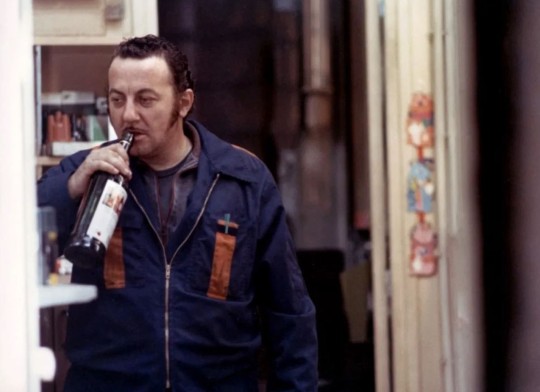
6 notes
·
View notes
Photo










La gueule ouverte 1974
#la gueule ouverte#1974#maurice pialat#philippe leotard#nathalie baye#hubert deschamps#est un génie#lumière#ces années là#parfois on vole#bresson#8/10
6 notes
·
View notes
Audio
Extrait musique du moyen métrage “Morphine” projet étudiant, récit conté par Philippe Léotard.
Auteur musique AtomX.
0 notes
Photo

Maurice Pialat
- The Mouth Agape / La gueule ouverte
(1974)
#maurice pialat#the mouth agape#la gueule ouverte#philippe léotard#philippe leotard#photo album#film#1974
19 notes
·
View notes
Video
youtube
La vie ?
Un vol de nuit vers la lumière, un éclat, un rire du feu, un éclair, un temps de chandelle, un coup d’orage au cœur, une foudre si douce qu’elle en fait rougir les baldaquins du ciel.
15 notes
·
View notes
Link
Tangos - El Exilio de Gardel (1985)
Roberto Goyeneche
Fernando “Pino” Solanas, que murió ayer en París, y que a fines de la década del 60 se había erigido como uno de los pilares del documental político latinoamericano con su mítica “La hora de los hornos” (cumbre del agit-prop), a mediados de los 80s regresó al cine después de una década con su musical surrealista. Un grupo de argentinos exiliados en París, que han huido de la sangrienta dictadura cívico militar argentina, intentan poner en escena una tanguedia (tango + tragedia + comedia). Entre la nostalgia por lo que cada uno dejó o perdió en Buenos Aires, las dudas entre volver o quedarse, las posibilidades que se abren en el extranjero a los que crecieron allí porque llegaron muy chicos se combinan con una fabulosa partitura de Astor Piazzolla, letras de Castiñeira de Dios y una coreografía espectacular para los números de baile. Tangos, el exilio de Gardel tiene la forma de un mosaico en el que las secuencias se suceden presentando al espectador diferentes facetas del drama de los exiliados mediante la trayectoria personal de un conjunto de personajes, entre los cuales destacan Juan Uno y Juan Dos. Pero Solanas no se contenta con tratar el tema del exilio: le brinda al espectador su propia representación de la dictadura argentina y en particular de sus aspectos más represivos y violentos. Dolorosa, pero también con muchos gags cómicos, reforzada por una increíble fotografía de Félix Monti (decididamente gloriosa en las escenas rodadas al alba o al anochecer). Lejos del didactismo y la propaganda política, repleta de hallazgos estéticos, con grandes actuaciones de Marie Laforêt, Miguel Ángel Solá, Philippe Leotard, Marina Vlady y Gabriela Toscano, y claro, con ese tono profundamente melancólico de Piazzolla. Gran Premio de Venecia, César a la Mejor Banda de Sonido y cantidad de premios más.
#pino solanas#astor piazzolla#exilio#paris#carlos gardel#tango#tanguedia#dictadura#argentina#francia#tragedia#comedia#roberto goyeneche#marie laforêt#1001 soundtracks#banda de sonido#ost
1 note
·
View note
Text
It still works! And so let us begin 12 days of Christmas.... [Video description; a light brown teddy bear with a red and white striped hat and scarf sits on a work top and plays jingle bells]

We went on a trip for a housewarming present and obviously just came back with a child friendly present and a photo

The other shopping decorations this year were a bit meh


Made up for it by going to the capital of Christmas though (Strasbourg)

To keep the children on their toes, our class had a giant festive treasure hunt across the school and we only had one team's worth of kids sent home for being COVID contact cases before the finale!

While we're here, your Christmas cards need customs declarations now


Anyway, not able to get everything I wanted in Strasbourg I took a tour of the Parisian markets and indulged in the traditional festive food of melted cheese

I also went to the ballet. They'd never agree but I'd say this could sneak by as fancy french pantomime. It had leotards, transvestism, audience participation, much laughter.... (picture from)
0 notes
Text
LES ENFANTS QUI S'AIMENT - PHILIPPE LEOTARD/ JACQUES PREVERT
LES ENFANTS QUI S’AIMENT – PHILIPPE LEOTARD/ JACQUES PREVERT
LES ENFANTS QUI S’AIMENT – PHILIPPE LEOTARD/ JACQUES PREVERT
Les enfants qui s’aimentS’embrassent debout contre les portes de la nuitEt les passants qui passent les désignent du doigtMais les enfants qui s’aimentNe sont là pour personne
Et c’est seulement leur ombreQui tremble dans la nuitExcitant la rage des passantsLeur rage, leur méprisLeurs rires et leur envie
Les enfants qui s’aimentNe…

View On WordPress
0 notes
Photo










L'ombre des châteaux 1976
#L'ombre des châteaux#1976#daniel duval#philippe leotard#albert dray#zoé chauveau#marcel dalio#loin#poésie#trop#vide#plein#6/10
4 notes
·
View notes
Photo

[RIP] Frank Vincent Gattuso, dit Frank Vincent ne joue plus les cadavres à l'âge de 78 ans (ne pas confondre avec Franky Vincent). Fils d'un métallurgiste élevé dans le New-Jersey avec ses frères Nick et Jimmy et sa demi soeur Fran, Frank a le pedigree idéal pour entrer dans la mafia. Il choisit pourtant de devenir acteur et il rencontre Jo Pesci sur son premier tournage, celui ci leur présente De Niro qui leur présente Scorsese. S'ensuit pour Frank une carrière dans la mafia sur grand et petit écran, de «Raging Bull», «les Affranchis» et «Casino» au magnifique Phil Leotardo des «Soprano» (ne pas confondre avec Philippe Leotard, décédé également) en passant par Spike Lee et ses «Do the right thing et «jungle fever». Adieu Frank.
5 notes
·
View notes
Photo

BALLET / 2018-2019
LE CORSAIRE
STUDENT GUIDE
WORKING REHEARSAL
MARIINSKY BALLET
With the Kennedy Center Opera House Orchestra
Original Choreography by Marius Petipa
Reconstructed choreography (1987) by Pyotr Gusev
Music by Adolphe Adan, Cesare Pugni, Léo Delibes, Riccardo Drigo and Pyotr Oldenburgsky
Libretto by Henri Vernoy de Saint-Georges and Joseph Mazilier and edited by Yuri Slonimsky and Pyotr Gusev
School Show: April 9
Teacher and Parent Guide: Le Corsaire
Before the curtain rises, a little history…
Whether or not you’ve touched a tutu or performed a plié, you’ve surely heard of Marius Petipa’s (pronounced PET-ee-pahs) ballets. Does Swan Lake ring any bells? What about Sleeping Beauty? And that holiday classic, The Nutcracker! But here’s the oddest thing: Petipa—born in France—is considered the “Father of Russian Ballet.” How’d that happen?
When Petipa arrived in St. Petersburg, Russia in 1847, he was considered just an “okay” dancer. Decades later, however, he had successfully danced his way up the ladder at the Russian Imperial Theatre. To celebrate this famous choreographer, the Mariinsky Ballet performs Le Corsaire (COUR-sair, The Pirate). Set on an island in Greece, this ballet is filled with exotic characters, a shipwreck, treachery, romance, betrayal, and a boatload of pirates!
About that pirate ballet…
The story of Le Corsaire was loosely adapted from Lord Byron’s poem of the same name. The first production was choreographed by Joseph Mazilier in 1856, but Mariinsky’s version is a reconstruction of Marius Petipa’s choreographic revival about 10 years later.
Now here’s the interesting part: Petipa didn’t just choreograph one production of Le Corsaire. He actually revived it four times—each time adding more pas (pronounced pah, incidental dance variations that don’t necessarily forward the plotline or character development). This shouldn’t come as a big surprise since Petipa was famous for developing the form of the grand ballet—a multi-act production with a fully-developed plot, pantomime acting, and lavish sets and costumes. And you’ll soon see that Le Corsaire absolutely fits that definition.
Who’s Who
Main Characters
Conrad, Birbanto, and Ali: shipwrecked pirates
Medora: the most beautiful woman on the Greek island
Gulnara: Medora’s friend
Lankedem: an evil slave trader
Seid Pasha: a rich sultan
So, What’s Going On?
Prologue: The Shipwreck
Three corsairs (“pirates” in French) struggle to save their boat during a storm. Their efforts fail and the boat sinks.
Act I
Scene 1: The Sea Shore
Shipwrecked on a Greek island, the corsairs named Conrad, Ali, and Birbanto are saved by a group of young women. If found by the Turkish patrols, the men will be in immediate danger. The women decide to hide them as one of the women, Medora, falls in love with Conrad. Meanwhile, Lankedem, an evil slave trader, is pillaging the Greek coast in search of women to seize and sell. The women successfully hide the corsairs but are captured by Lankedem’s men.
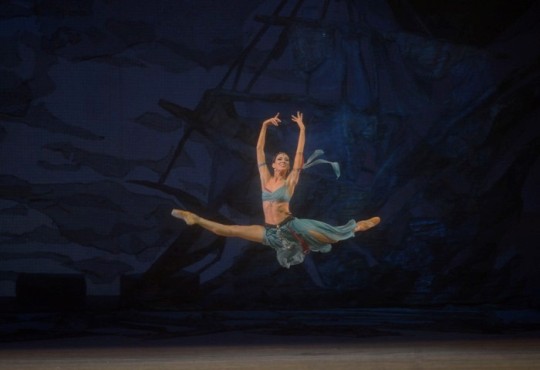
Caption: Mariinsky dancers are renowned for their impeccable technique and their focus on storytelling.
Credit: Viktoria Tereshkina in Le Corsaire by Valentin Baranovsky ™ State Academic Mariinsky Theatre
Scene 2: The Slave Market
From his powerful throne in the marketplace, the sultan Seid Pasha is eager to add young women to his harem. Lankedem is equally enthusiastic to fill the sultan’s wish and sells Medora’s friend Gulnara to him. Then, just as Medora is brought in, another bidder enters the market area—the pirate Conrad in disguise. When Seid Pasha confronts Conrad, the other corsairs throw off their cloaks, seize the evil Lankedem, and rescue the women. The Seid Pasha is furious at the useless Turkish patrol.

Caption: Pas (incidental dance variations) are common in Petipa ballets. While these dance variations might not move the plot forward, they still help the audience better understand the characters.
Credit: David Zaleyev in Le Corsaire by Natasha Razina ™ State Academic Mariinsky Theatre
Act II: The Corsairs’ Cave
The corsairs cheer the rescued women as well as the money they stole from the sultan. In celebration, Medora dances with Conrad and his friend Ali. The other women, however, express to Medora their desire to return home to their villages. Birbanto wants the women to stay, but Conrad is convinced by Medora to take the women home. Lankedem watches this conflict grow between Conrad and Birbanto. In exchange for his freedom, he offers Birbanto a sleeping potion. The plan is for Birbanto to pour the potion on a bouquet of flowers and give it to Medora. Medora passes the flowers to Conrad to thank him for his chivalry. Conrad falls asleep as Lankedem abducts Medora and he escapes the cave.
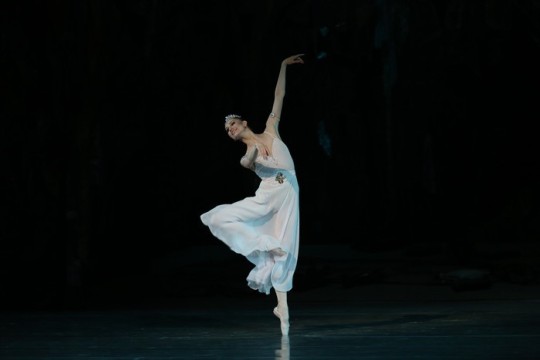
Caption: Medora is considered the most beautiful woman on the island; her movements are graceful and virtuosic.
Credit: Oxana Skorik in Le Corsaire by Natasha Razina ™ State Academic Mariinsky Theatre
Act III: The Seid Pasha’s Harem
Lankedem brings Medora to Seid Pasha’s harem, where he eagerly buys her from the slave trader and celebrates his new prize in his “garden of beauties.” Suddenly, mysterious pilgrims enter the palace and are invited to join the evening prayer. But Medora recognizes the visitors to be the corsairs, once again in disguise. The pirates surprise attack Lankedem’s patrol and Conrad saves Medora once and for all.
Epilogue
Medora, Conrad, and their friends sail toward their next adventure.
Check This Out…
Everything about this production is grand—from the spectacular sets and ornate costumes to the challenging choreography and large cast of dancers. The intricate plot calls for such grandeur, but it is also a famous quality of the Mariinsky company itself. Let’s take a closer look at what makes this production so impressive.
What to Look for:
SETS
The sets in Le Corsaire feature spectacular backdrops, curtains, and panels that set the scene without taking up the dancers’ real estate on the stage. There are a couple of scenes (including the slave auction) where there is a small platform on stage. But for the most part, the stage is wide open. This allows for a large number of dancers to be on stage and for them to perform dynamic, traveling choreography. This is particularly noticeable in the opening of Act II where the corsairs and women are celebrating.

Caption: A scene inside the elaborate cave setting.
Credit: Viktoria Tereshkina & Andrei Yermakov in Le Corsaire by Valentin Baranovsky ™ State Academic Mariinsky Theatre
COSTUMES
The costume design in Le Corsaire fuses Eastern-inspired apparel like harem pants and intricately wrapped stomach baring tops, with more traditional ballet apparel and accessories, including grand tutus and leotards and tights. Both the men and the women are dressed from head to toe. Headpieces and hats, facial hair and wigs, jewelry, and specially crafted shoes all reinforce characterization in Le Corsaire.
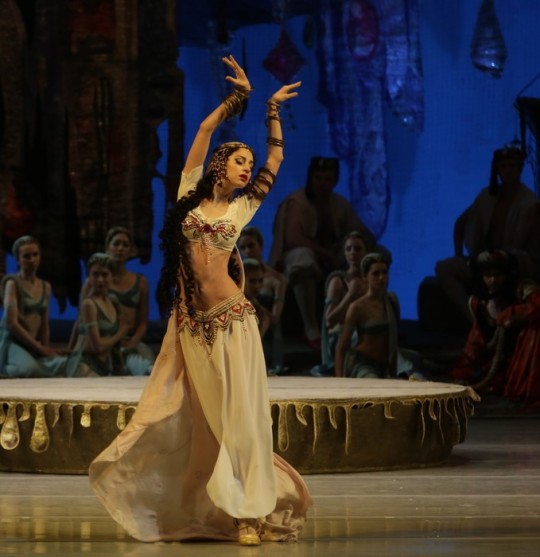
Caption: The costumes in Le Corsaire are extremely detailed and ornate—from the dancer’s headpiece and hairstyle to the pattern on her shoes.
Credit: Olga Belik in Le Corsaire by Natasha Razina ™ State Academic Mariinsky Theatre
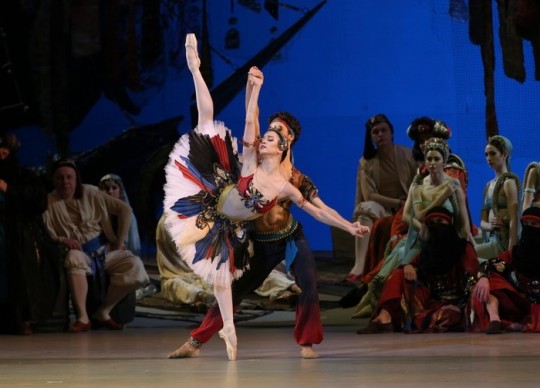
Caption: The costume design fuses traditional ballet tutus and pointe shoes with more Eastern inspired apparel.
Credit: Renata Shakirova & David Zaleyev in Le Corsaire by Natasha Razina ™ State Academic Mariinsky Theatre
CHOREOGRAPHY
Le Corsaire features both virtuosic choreography as well as elaborate pantomime. In fact, the character of Conrad initially didn’t dance at all—he only acted through pantomime.
Pay attention to the height of their jétes (zhuh-TAYS, jumps), intricate pirouettes (peer-WET, whirls or spins sequences), and effortless athleticism. Additionally, the corps de ballet (core duh bah-LAY, dancers in a company that perform as a group) demonstrates its unity of style.
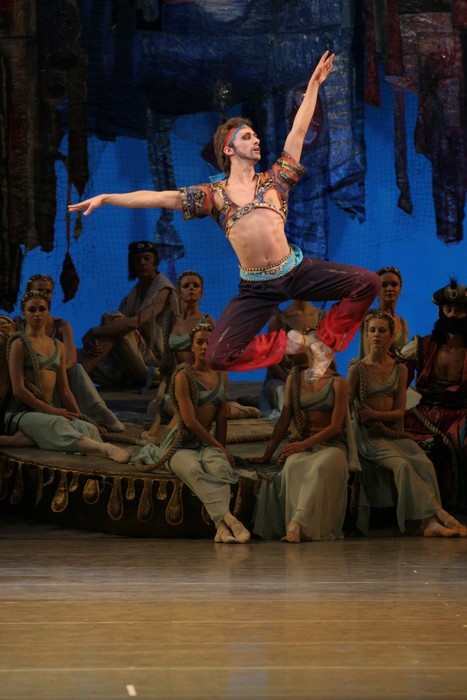
Caption: Years of training allows this dancer to travel through the air with amazing flexibility and height, making this difficult jump look effortless.
Credit: Philipp Stepin in Le Corsaire by Natasha Razina ™ State Academic Mariinsky Theatre
Additionally, Mariinsky dancers have distinguished themselves for their beautiful port de bras (pawr duh BRAH, technique of moving arms gracefully) and epaulement (ay-pohl-MAHN, placing of the shoulders and head). This meticulous attention to expression, fluidity, and detail gives a sense of aristocratic elegance.

Caption: The corps de ballet often works as a backdrop to the principal dancers.
Credit: Renata Shakirova in Le Corsaire by Natasha Razina ™ State Academic Mariinsky Theatre
The female dancers don’t always wear pointe shoes. They perform the more folkloric choreography in character shoes with a short heel.
Pantomime is a major element of Le Corsaire. It often helps to set the scene but is also incorporated into much of ballet choreography. For example, watch how Seid Pasha’s movements and gestures tell much about his intentions. Another dramatic moment of pantomime is when Conrad smells the bouquet of poisoned flowers at the end of Act II.
What to Listen for:
The score for Le Corsaire is a hodgepodge of tunes from many ballet composers, the result of scenes added over many years by Petipa. The “legend” is that ballerinas would often demand “a special solo” be added whenever they entered a production. Over time, each favorite solo became part of the standard version. In fact, ballets like Corsaire, (which didn’t start with a strong central score like Swan Lake and The Sleeping Beauty), were often subject to these kinds of musical additions.
Listen closely. Some music seems more Eastern Greek-inspired with accents from tambourines and flutes while other compositions sound like they may have come from another ballet like Swan Lake or The Sleeping Beauty.
What to Think About:
Le Corsaire has been performed internationally for over 250 years. Why do you think it remains so popular?
How is Le Corsaire similar to ballets you might have seen in the past? Can you make a list of qualities common among Petipa’s ballets or other classical ballets?
“Seeing a ballet” means more than simply watching dancers dance. A ballet is a total theatrical production with all parts working together, from the sets and costumes to the music and choreography. Think about how seeing Le Corsaire has changed your perception of ballet.
Let’s Talk About Shoes
In Le Corsaire, the ballerinas perform in both pointe shoes and heeled shoes. For some background info, here’s a bit of history behind the evolution of the ballet shoe.
Ballet and pointe shoes might seem inseparable today, but the art of ballet actually came about 200 years before ballerinas began dancing on their tiptoes. The Royal Academy of Dance was founded in France by King Louis XIV in the mid-seventeenth century. While ballet was practiced all throughout Europe, this Academy helped codify the language of the art form (which is why ballet terminology is in French). As ballet grew out of the social court dances, both male and female dancers wore heeled shoes (as you’ll see many dancers wear in the start of Act II). As you can imagine, heels inhibited a lot of movement. The heel was “dropped” in the early eighteenth century; the more formal shoe allowed for greater articulation of the foot (think of demi-pointe/soft ballet slippers that we have today).
By the late eighteenth century, choreographers began experimenting with wires and harnesses to elevate dancers from “mortal to ethereal.” Dancers also began stuffing their shoes with padding to get higher and higher on relevé (reh-luh-VAY, a raised body). Soon after, alterations were made to the shoes themselves to make this toe work more possible. The pointed-tip shoes were swapped with a sturdy front platform, or a layered fabric “box” to encase the toes, and a stiffer (but silent) sole. What we consider “modern day” pointe shoes are even stronger and sturdier than those early versions.
Surprisingly, the pointe shoe has remained relatively unchanged over the past 200 years despite the increasing demands of modern ballet dancing. A professional ballerina can wear up to 120 pairs of pointe shoes in a year and will often “alter” her shoes depending on a particular role (breaking them in more or stiffening them to last longer). Dance shoe companies provide the pointe shoes—the tools for the art—but it is often the dancer’s responsibility to mold and shape the shoes to fit her needs (and to care for her feet with tape, toe pads, etc.).
Learn more about the pointe shoe with this ARTSEDGE resource.
Take Action: Tell Your Story
Classical ballets were generally based off well-known fairy tales, fables, and folklore. Some examples are The Sleeping Beauty, Romeo and Juliet, and Swan Lake. Le Corsaire follows this model in the story elements of a shipwreck, a sleeping potion, and a happily-ever-after ending.
Think of a well-known story you especially enjoy—anything from the Three Little Pigs to Spider-Man. Either by yourself or with a group of classmates or friends, tell your story through movement using choreography and/or pantomime. Like a game of charades, communicate your tale without speaking. If you choose to present your work to your class or family, see if they can guess the story you’ve chosen to tell.
EXPLORE MORE
Go even deeper with the Le Corsaire Extras.
-
Top Photo: Le Corsaire by Valentin Baranovsky™ State Academic Mariinsky Theatre
Writer: Mary Callahan
Content Editor: Lisa Resnick
Logistics Coordination: Katherine Huseman
Producer and Program Manager: Tiffany A. Bryant
-

David M. Rubenstein
Chairman
Deborah F. Rutter
President
Mario R. Rossero
Senior Vice President
Education
Support for Ballet at the Kennedy Center is generously provided by Elizabeth and C. Michael Kojaian.
International Programming at the Kennedy Center is made possible through the generosity of the Kennedy Center International Committee on the Arts.
Major support for educational programs at the Kennedy Center is provided by David M. Rubenstein through the Rubenstein Arts Access Program.
Kennedy Center education and related artistic programming is made possible through the generosity of the National Committee for the Performing Arts.
© 2019 The John F. Kennedy Center for the Performing Arts
0 notes
Text
COMPLEXIONS CONTEMPORARY BALLET
Now celebrating a quarter-century of existence, COMPLEXIONS CONTEMPORARY BALLET, founded and directed by Dwight Rhoden and Desmond Richardson, has assembled a company of sixteen of the most spectacular imaginable dancers. These technical phenoms have various dance backgrounds and training, but many come from the world of competition dance, where the sky’s the limit for virtuosity and energetic projection. Then, Rhoden and Richardson have honed them to a razor’s edge with their proprietary NIQUE technique, which can apparently take talented dancers to the next level of dazzlement, judging by their Wednesday evening performance.
Chief choreographer, Rhoden, has often faced criticism, especially from the New York press, for the density of movement in his works, which are non-stop motion at the extreme ends of flexibility and physicality. In this two-week season at the Joyce Theater, February 19- March 3, the company is showing two different programs – and a third configuration at matinees – that encompass its history and highlight the development of its esthetic of physicality to the max.

COMPLEXIONS in BACH25 by Dwight Rhoden. photo by Sharon Bradford
Program A comprises the New York premiere of “Bach 25” (2018), set to richly orchestrated music by Johann Sebastian and Carl Philipp Emanuel Bach, and a tribute to David Bowie, “Star Dust” (2016), using his iconic songs. In both works you can see Rhoden’s skill at crafting his chosen vocabulary – balletic lines, infused with influences from folk, African, club, and disco styles. His transitions tend to be seamless with, say, one of a pas de deux, exiting as others enter in the nick of time to pick up the movement of the remaining partner in perfect unison. From a seeming chaos of bodies, running or doing individual phrases, suddenly will emerge order – four or five couples doing an overhead lift in unison, then dissolving again into individual agendas.

COMPLEXIONS in STAR DUST (center) Brandon Gray. photo by sharon Bradford
The second ballet on the program “Star Dust” is in nine sections that are as theatrically presentational as “Bach25” is presentationally abstract. Dance soloists portray Bowie’s personas, lip-syncing his lyrics while dancing up a storm, and backed by the colorfully-clad company in garish, body-hugging outfits by Darch that allude to the club culture of the albums from 1969 to 2016. In “Space Oddity,” Maxfield Haynes starts with a Rhoden signature move – deep plie in second position, legs wide apart. Haynes is wearing pointe shoes; he struts around the stage on toe, like a runway diva with psychedelic makeup.
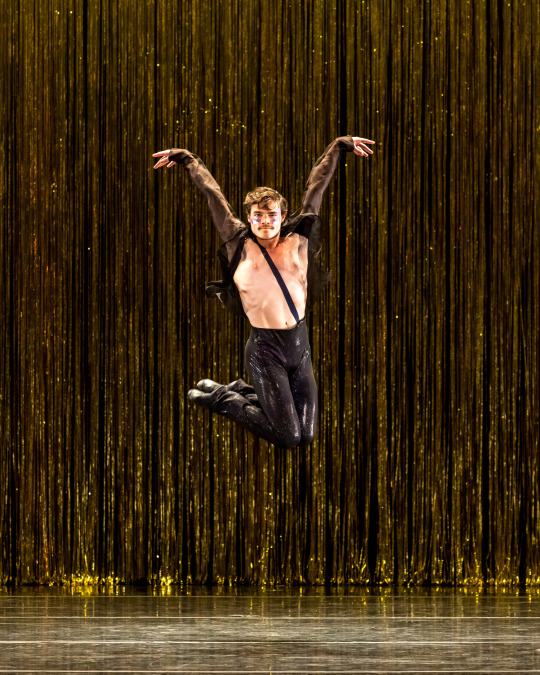
Tim Stickney in Dwight Rhoden’s STAR DUST. photo by Sharon Bradford
As “Lazarus,” Brandon Gray divides his face in two with a stripe of silver glitter running down the middle. Simon Plant with a glitter star surrounding one eye, devours the space like a menacing maniac in “Rock and Roll Suicide.” Tim Stickney in black trousers and a leather strap across his bare chest portrays a speculative “1984” humanoid from the eponymous 1974 album. And the spidery six-foot-tall Jillian Davis takes the lead in “Heroes,” sung by Peter Gabriel.
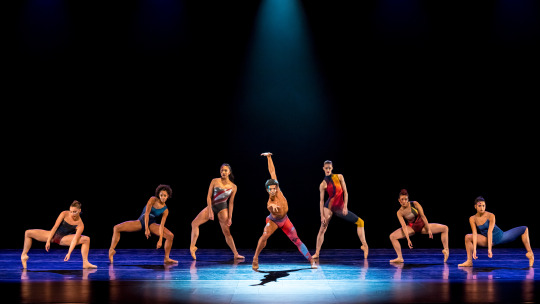
COMPLEXIONS in Dwight Rhoden’s STAR DUST (center) Miguel Solano. photo by Sharon Bradford
A gold fringe curtain and three disco balls fly in for some of the scenes, heightening the glam-rock ambience and letting the dancers come and go upstage for a welcome change. “Modern Love” and “Young Americans” are full-company blasts. And, as usual, Michael Korsch’s imaginative, technically cutting-edge lighting pinpoints and color-washes the stage with dazzling, kaleidoscopic effects that still manage to highlight the extraordinary dancing.

COMPLEXIONS in Dwight Rhoden’s STAR DUST (center) Brandon Gray. photo by Sharon Bradford
Program B, seen on February 26, opens with “From Then to Now,” six audience favorites from Rhoden’s repertory, done with a brief blackout between each. Rhoden has cast these short dances to showcase the notable gifts of his dancers. The curtain ascends on “Rise” (2008) with Tim Stickney running frantically in place to the persistent pulse of U2’s “Where the Streets Have No Name.” The other dancers emerge from the darkness at the back, echoing Stickney’s motif with the fierce energy that characterizes everything they do.
In the duet “Spill” (2010) to contemporary classical music by Joan Jeanrenaud, newcomer Maxfield Haynes manipulates five-year company veteran Shanna Irwin in a pas de deux of continuously entwining lifts. “Wonder-Full” (1994) is a sinuous solo danced to Stevie Wonder’s “All in Love is Fair” by Brandon Gray in white shorts and a silky purple shirt that he removes midway through, so we can see not only the maximum flex of his every sinew, but also his utter control and performing passion.
“Choke” (2006) is a break-neck duet for Thomas Dilley and Simon Plant, both relatively new Complexions dancers with matching, compact builds, who personify the technical precision and difficulty of a side by side duet that switches back and forth from unison to symmetry. In “Testament” (2011) to the traditional “Amazing Grace” limber, lanky Davis in a patterned leotard and tall, lithe Gray in a kilt electrify the space with their extreme flexibility and attack. The final dance is the full-company, “Modern Love” section from “Star Dust,” to end the first act with a bang.
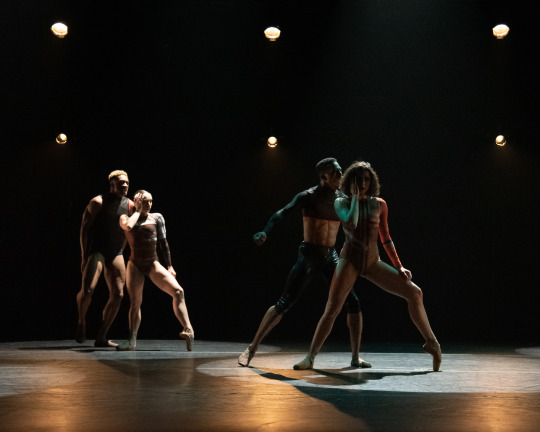
COMPLEXIONS in Dwight Rhoden’s WOKE (l-r): Brandon Gray, Shanna Irwin, Jared Allan Brunson, Daniela O’Neil. photo by Nina Wurtzel
The premiere “Woke” is another nine-part suite that serves, in Rhoden’s words, as “a physical reaction to the daily news.” It uses diverse musical selections by rock and rap artists with ominous titles like “Ball of Confusion (That’s What the World is Today),” “Doomed,” “Killing Spree,” and more reassuring ones – “Peace Piece,” “Mona Lisa,” and “Pray.” Here again, most of the men are bare-chested under sheer tunics and shorts or knee-length leggings, and the women each wear unique, skin-revealing outfits and point shoes (which are later replaced with soft ballet slippers.)

COMPLEXIONS in Dwight Rhoden’s WOKE. photo by Nina Wurtzel
Their interactions start out belligerent and confrontational in continuous duets and trios, which are often juxtaposed with each other on opposite sides of the stage. Korsch’s lighting is stark and shadowy with downward spots that etch the dancers in three-dimensional relief. Here, even more than elsewhere in the repertory, the sky-high leg extensions of both the men and women become thematic. In a brief solo, the small, beautifully-proportioned Plant unfolds his right leg slowly into a twelve o’clock-high extension, which he holds, rock-steady, before rising to the half toe of his standing foot. So spectacular is this feat of flexibility and control it draws applause, although it’s matched elsewhere by equally gasp-worthy contortions – sliding splits, a back walkover, quadruple pirouettes, and spread-legged slides.

COMPLEXIONS in Dwight Rhoden’s WOKE (l-r): Eriko Sugimura, Craig Dionne. photo by Joseph Franciosa
But “Woke”’s vocabulary is also peppered with flapping hands, full-body spasms, and other gestures that add dramatic pungency; it’s moody, angst-filled, and emotionally dark. At the end of one climactic group passage, the empowered women whack their partners to the ground. One of the raps is a remarkable screed using variations of the initials R.I.P. – Raised In Poverty, Remain In Peace, Realness I Preach, etc. – while bodies lie twitching on the ground and others dance oblivious behind them.
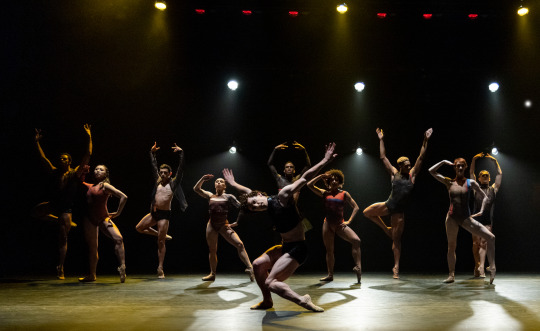
COMPLEXIONS in Dwight Rhoden’s WOKE (center) Simon Plant. photo by Nina Wurtzel
Rhoden’s choreography is seductive. Its technical difficulty, non-stop kinetic flow, and physical invention is thoroughly impressive. It’s salient shortcoming is the repetitiousness of spatial patterns and often two-dimensional use of stage space. Dancers sprint on and off from the sides of the stage, just in time to start a phrase or to join one in progress, and they tend to face front, as if performing into a mirror.
But for all its dramatic implications, at the end, there is redemption. The dancers in alternating rows of four – men, women, men, women – outstretch their hands to us in a gesture of invitation or offering, to the melodic strains Bill Evans’s “Peace Piece,” as the curtain slowly descends.
Gus Solomons jr, © 2019
0 notes
